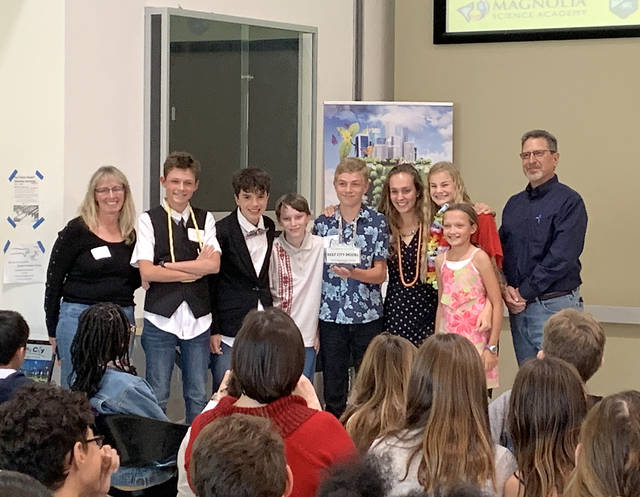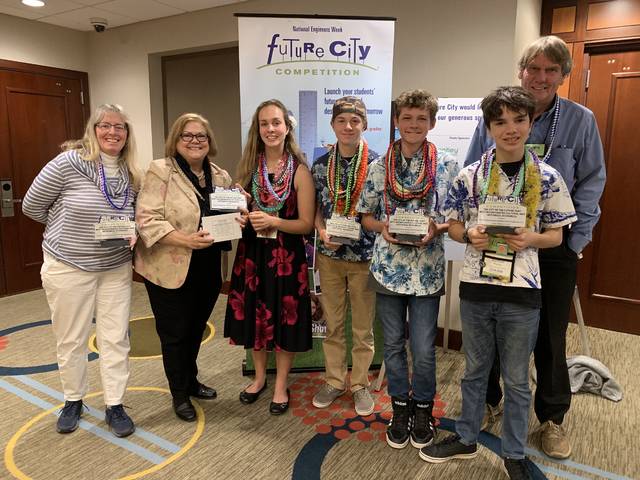Hawaii Island youth team’s vision earns prize in Washington, D.C. competition

From left, Dawn Johansen, Jaxen Flegel, Ashton Phelps, Matthew Johansen, Cody Baker, Olivia Malouf, Corinne Baker, Ella Flegel and a judge for the Future City Competition pose for a photograph at the awards ceremony for the Southern California regional Future City competition in January. (Photo courtesy Dawn Johansen/Special to West Hawaii Today)

From left, Dawn Johansen, an unidentified Future City Competition judge, Olivia Malouf, Cody Baker, Jaxen Flegel, Ashton Phelps and John Johansen pose during the Future City Competition national finals. (Photo courtesy Dawn Johansen/Special to West Hawaii Today)
KAILUA-KONA In the year 2118, Ka Hopena Kokua sits about three and a half miles off the Kona Coast, an island made up of many interlocking hexagons.
KAILUA-KONA — In the year 2118, Ka Hopena Kokua sits about three and a half miles off the Kona Coast, an island made up of many interlocking hexagons.
Each hexagon is its own “microgrid,” powered completely by renewable energy, including buoyant aerial turbines that generate power from the wind, with five days of backup power available, while Tesla coils inside the cavities of the hexagons wirelessly transmit power throughout the island.
“Since we picked the Tesla coils, it takes it to where then we don’t have to worry about a hurricane or strong winds knocking over the power poles,” said Cody Baker. “And it is safely under all of our hexagons.”
Baker, 14, is one of seven Hawaii Island youth that traveled to the nation’s capital last month to make history and build the future as the first team to represent the state at the national level of the Future City competition, which challenges students to envision cities of the future and work to tackle the problems their communities could face in the century ahead.
“I feel like we have a lot, a lot more knowledge than we used to, because we know all the engineering, like the engineering process,” Baker said. “We know how a city runs, and I think we know a lot more than when we started.”
COMPETITION PRIZE
The team, one of two from here to compete at an earlier regional competition, came away from the national contest with a prize for “The city of the future that best incorporates cultural and historical resources.”
The Future City Competition encourages students to imagine the cities of tomorrow and then design solutions for challenges those communities might face.
Contestants are tasked with creating a city 100 years from now, extrapolating the approximate population increase and incorporating innovative and futuristic technologies that can be scientifically demonstrated to be feasible a century from now.
While previous years have covered everything from stormwater management to urban agriculture, this year, students were challenged to design a power grid for their city that could withstand and recover from the effects of a natural disaster.
Looking at the impact 100 years of continued development and population growth could have on Kona and its resources, the team knew they didn’t want to risk the region losing its unique culture.
“Tourism is their No. 1, and they didn’t want to make it look like everybody else’s city, which is building after building and no natural and no real culture,” said Dawn Johansen, who led the Future City effort in Hawaii. “And they wanted to be able to preserve the heritage of what Hawaii is.”
They set their sights on building an island, named “Ka Hopena Kokua,” three and a half miles off the Kona coast, taking into consideration environmental impacts for everything from migratory whales to coral as well as requirements set by the Federal Aviation Administration. It’s also designed to be mobile to maneuver its parts away from potential threats.
“This floating Island would maintain the feel of the Big Island with open spaces, and outdoor activities, but allow the infrastructure that was needed to be built into the island itself,” wrote Johansen in a description of the team’s project. “The focus was on having a community feel to the futuristic island.”
For Ka Hopena Kokua, the natural disaster was a hurricane modeled after Hurricane Lane, which barreled south of the islands this past August dropping more rainfall than any tropical storm or hurricane in the state’s history. In this model though, the island sustains a direct hit by the storm.
After speaking with representatives from the Hawaii Electric Light Co., the students learned that the biggest problem comes with transmission lines going down.
“Because they realized that without power, everything comes to a screeching halt,” said Johansen, “from water to medical to just everything.”
Their research into a number of possible solutions led them to the idea to use Tesla coils to distribute the power wirelessly.
Prior to the national competition, Ka Hopena Kokua won best overall model and overall best team at regionals. The other local team, “Aloha Kai,” took the People’s Choice prize at that level of the competition.
EMPOWERING LESSONS FOR STUDENTS
For the three students who spoke with West Hawaii Today, all said they were motivated by an interest in engineering, giving them an opportunity to explore the diverse fields of engineering.
“I feel like I learned enough to where I could walk into a conversation where people are talking about something and be able to contribute to that conversation and feel like I’m actually giving information,” said Olivia Malouf, 14, “and that I know stuff.”
Ashton Phelps, 13, said the experience exposed him to the variety of fields within engineering.
“Because I’ve been wanting to become an engineer before this,” he said, “but I didn’t know what engineering field I really wanted, so that’s why I loved Future City.”
Baker said the experience taught him just how much work goes into running a city. When they were working on the model component of their project, he said, there were no limits, giving him and his teammates the opportunity to think of an idea and incorporate it into their project.
The students said they came away feeling more empowered through their participation in the contest as a result of researching and testing the viability of potential ideas that have been put out there that might not yet have been fully applied in the real world.
“Another thing — on top of learning and researching all of this amazing technology that’s coming up — is it gives us the opportunity to dream about what our futures might be like and all that wonderful stuff,” said Malouf, adding that she believes it’s a field she could see herself pursuing as a profession.
Johansen, meanwhile, said she’s seen how taking on the challenges of the Future City competition empowers students to recognize they can be part of solutions for the problems society faces.
“And it unlocks in them the ability to dream and to think outside the box,” she said. “I think too often we put kids in a box and they don’t feel like they have any chance of being able to do anything different. And every time I’ve run this program, the kids always come out of it realizing, ‘wow,’ they could do this, they could do that.”


